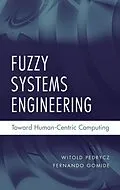A self-contained treatment of fuzzy systems engineering, offering
conceptual fundamentals, design methodologies, development
guidelines, and carefully selected illustrative material
Forty years have passed since the birth of fuzzy sets, in which
time a wealth of theoretical developments, conceptual pursuits,
algorithmic environments, and other applications have emerged. Now,
this reader-friendly book presents an up-to-date approach to fuzzy
systems engineering, covering concepts, design methodologies, and
algorithms coupled with interpretation, analysis, and underlying
engineering knowledge. The result is a holistic view of fuzzy sets
as a fundamental component of computational intelligence and
human-centric systems.
Throughout the book, the authors emphasize the direct applicability
and limitations of the concepts being discussed, and historical and
bibliographical notes are included in each chapter to help readers
view the developments of fuzzy sets from a broader perspective. A
radical departure from current books on the subject, Fuzzy Systems
Engineering presents fuzzy sets as an enabling technology whose
impact, contributions, and methodology stretch far beyond any
specific discipline, making it applicable to researchers and
practitioners in engineering, computer science, business, medicine,
bioinformatics, and computational biology. Additionally, three
appendices and classroom-ready electronic resources make it an
ideal textbook for advanced undergraduate- and graduate-level
courses in engineering and science.
Autorentext
Witold Pedrycz, PhD, is Professor and Canada Research Chair in Computational Intelligence at the University of Alberta, Canada. His research interests include granular computing, including fuzzy set technology, neural networks and evolutionary computing, pattern recognition, data mining, and emerging behavior and adaptive systems. He has authored or edited eight books, over 200 papers in journals or volumes, and over forty conference papers. He is a Fellow of the IEEE and IFSA.
Fernando Gomide, PhD, teaches in the Department of Computer Engineering and Industrial Automation at the State University of Campinas (UNICAMP) in São Paulo, Brazil. His areas of interest include fuzzy sets and logic, artificial intelligence, and genetic algorithms.
Klappentext
A self-contained treatment of fuzzy systems engineering, offering conceptual fundamentals, design methodologies, development guidelines, and carefully selected illustrative material
Forty years have passed since the birth of fuzzy sets, in which time a wealth of theoretical developments, conceptual pursuits, algorithmic environments, and other applications have emerged. Now, this reader-friendly book presents an up-to-date approach to fuzzy systems engineering, covering concepts, design methodologies, and algorithms coupled with interpretation, analysis, and underlying engineering knowledge. The result is a holistic view of fuzzy sets as a fundamental component of computational intelligence and human-centric systems.
Throughout the book, the authors emphasize the direct applicability and limitations of the concepts being discussed, and historical and bibliographical notes are included in each chapter to help readers view the developments of fuzzy sets from a broader perspective. A radical departure from current books on the subject, Fuzzy Systems Engineering presents fuzzy sets as an enabling technology whose impact, contributions, and methodology stretch far beyond any specific discipline, making it applicable to researchers and practitioners in engineering, computer science, business, medicine, bioinformatics, and computational biology. Additionally, three appendices and classroom-ready electronic resources make it an ideal textbook for advanced undergraduate- and graduate-level courses in engineering and science.
Inhalt
Preface.
1 Introduction.
1.1 Digital communities and a fundamental quest for human-centric systems.
1.2 A historical overview: towards a non-Aristotelian perspective of the world.
1.3 Granular Computing.
1.4 Quantifying information granularity: generality versus specificity.
1.5 Computational Intelligence.
1.6 Granular Computing and Computational Intelligence.
1.7 Conclusions.
Exercises and problems.
Historical notes.
References.
2 Notions and Concepts of Fuzzy Sets.
2.1 Sets and fuzzy sets: a departure from the principle of dichotomy.
2.2 Interpretation of fuzzy sets.
2.3 Membership functions and their motivation.
2.4 Fuzzy numbers and intervals.
2.5 Linguistic variables.
2.6 Conclusions.
Exercises and problems.
Historical notes.
References.
3 Characterization of Fuzzy Sets.
3.1 A generic characterization of fuzzy sets: some fundamental descriptors.
3.2 Equality and inclusion relationships in fuzzy sets.
3.3 Energy and entropy measures of fuzziness.
3.4 Specificity of fuzzy sets.
3.5 Geometric interpretation of sets and fuzzy sets.
3.6 Granulation of information.
3.7 Characterization of the families of fuzzy sets.
3.8 Fuzzy sets, sets, and the representation theorem.
3.9 Conclusions.
Exercises and problems.
Historical notes.
References.
4 The Design of Fuzzy Sets.
4.1 Semantics of fuzzy sets: some general observations.
4.2 Fuzzy set as a descriptor of feasible solutions.
4.3 Fuzzy set as a descriptor of the notion of typicality.
4.4 Membership functions in the visualization of preferences of solutions.
4.5 Nonlinear transformation of fuzzy sets.
4.6 Vertical and horizontal schemes of membership estimation.
4.7 Saaty's priority method of pairwise membership function estimation.
4.8 Fuzzy sets as granular representatives of numeric data.
4.9 From numeric data to fuzzy sets.
4.10 Fuzzy equalization.
4.11 Linguistic approximation.
4.12 Design guidelines for the construction of fuzzy sets.
4.13 Conclusions.
Exercises and problems.
Historical notes.
References.
5 Operations and Aggregations of Fuzzy Sets.
5.1 Standard operations on sets and fuzzy sets.
5.2 Generic requirements for operations on fuzzy sets.
5.3 Triangular norms.
5.4 Triangular conorms.
5.5 Triangular norms as a general category of logical operators.
5.6 Aggregation operations.
5.7 Fuzzy measure and integral.
5.8 Negations.
5.9 Conclusions.
Exercises and problems.
Historical notes.
References.
6 Fuzzy Relations.
6.1 The concept of relations.
6.2 Fuzzy relations.
6.3 Properties of the fuzzy relations.
6.4 Operations on fuzzy relations.
6.5 Cartesian product, projections and cylindrical extension of fuzzy sets.
6.6 Reconstruction of fuzzy relations.
6.7 Binary fuzzy relations.
6.8 Conclusions.
Exercises and problems.
Historical notes.
References.
7 Transformations of Fuzzy Sets.
7.1 The extension principle.
7.2 Compositions of fuzzy relations.
7.3 Fuzzy relational equations.
7.4 Associative Memories.
7.5 Fuzzy numbers and fuzzy arithmetic.
7.6 Conclusions.
Exercises and problems.
Historical notes.
References.
8 Generalizations and Extensions of Fuzzy Sets.
8.1 Fuzzy sets of higher order.
8.2 Rough fuzzy sets and fuzzy rough sets.
